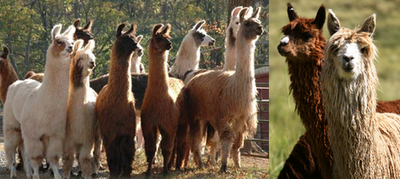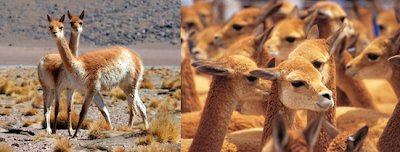The guanaco and vicuña are now
relatively rare wild species but are probably the ancestors of the domesticated
llama and alpaca. Alpacas and llamas may have been domesticated as early as
4000 BC.
LLAMAS
The llama (Lama glama) is widely
used as a pack and meat animal by Andean cultures since pre-Hispanic times. The
llama is a South American relative of the camel, though the llama does not have
a hump. The height of an adult llama is 15.5 to 6.0 feet tall at and they can
weigh between 280 to 450 pounds. Llamas
contribute much more than transportation to the human communities in which they
live. Leather is made from their hides, and their wool is crafted into ropes,
rugs, and fabrics. Llama excrement is dried and burned for fuel. Even in death,
llamas can serve their human owners—some people slaughter them and eat their
meat.
 |
| Llamas around Machu Picchu & Colca Canyon |
ALPACAS
There are two types of alpacas: Suri
and Huacaya. The fleece of the Suri hangs
in pencil locks, while the Huacaya
fleece is more like sheep's fleece without the lanolin.Adult alpacas usually weigh between 125 and 200 pounds and yield 5 to 8
pounds of fleece annually. Shearing is done in the spring to keep the alpaca
comfortable during the summer months. Alpacas come in 16 different colors
ranging from white to black, beige to dark brown. The fleece is prized by
spinners for its softness and is warmer and lighter weight than wool. People
who are allergic to wool can often wear garments made of alpaca, which is as
soft as cashmere.
 |
| Alpacas in a Farm |
VICUÑAS
It is a relative of the llama and is now believed to share a wild
ancestor with domesticated alpacas, which are raised for their fiber. They are the smallest members of the
camel family. These social animals live in family groups of up to twenty-five
individuals, which usually consist of one dominant male and his harem of
females and their young. The male is
extremely protective of his harem. He has a specialized call to warn of
potential predators and he fights with other males — bouts in which, among
other things, the opponents may spit at each other. Vicuñas have the finest wool in the world but since it is sensitive to chemical
treatment, the wool is usually left in its natural color.
 |
| Vicuñas |
GUANACOS
Guanaco is the largest wild member
of the Camelid family in South America, and is believed to be
the ancestor of the domestic llama. They
stand between 3.5 and 4 feet high at the shoulder and weigh up to 300 pounds.
They live in groups of up to ten females, their young, and a dominant male
adult. Throughout their range, guanacos occupy lands that tend to be very dry.
Guanacos were once overhunted for their thick, warm wool. Now they thrive in
areas protected by law. The guanaco's soft wool is valued second only to that
of the vicuña.
 |
| Guanacos |
In destinations as Arequipa city,
Colca Canyon, Cusco city, Sacred Valley & Machu Picchu and also on the way
from Puno to Cusco, these beautiful animals are easy to see. They are also some
farms where tourists can stop to spend sometime around these unique animals. Be
sure you will see them if you come to this part of the world!
Web form powered by 123ContactForm.com | Report abuse


No comments:
Post a Comment
Please tell us your comments